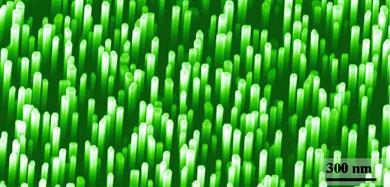Flexible source of electricity could be harnessed to drive molecular devices
Nanomachines sound like a great idea, but where is the nanobattery to power them? The problem could be solved with piezolelectric nanowires (NWs), tiny strips of matter a few atoms wide that give out electricity when they are flexed.
Zhong Lin Wang and his co-workers at Georgia Institute of Technology, Atlanta, US, were the first to observe a piezoelectric effect in NWs earlier this year.1 They caused a series of semiconducting zinc oxide (ZnO) NWs to bend by dragging the tip of an atomic force microscope (AFM) over a vertical array of NWs on a conducting surface.
The strained NWs gave out an electric current which could be detected by the AFM. Once the tip passed over the wires and they sprung back to their upright position, the current returned to zero.

Wang has now studied the effect in a single NW and a single ’nanobelt’, a flattened version of the wire, to help understand how they could be integrated into self-powered nanodevices.
Wang believes that small arrays of NWs built on flexible supports could power biosensors, with the mechanical energy coming from muscle movement or blood flow. Remote sensors that could operate underwater and pressure sensors for aircraft are also realistic applications, he said. The research is reported in the journal Nano Letters.2 ’Our focus is now on fabrication and optimisation,’ Wang told Chemistry World, adding that ’we’ve made drastic progress in the last months’. He claims to have already solved several key problems, including how to flex the arrays without an AFM. ’We could put them in the heel of a shoe to generate electricity as you walk,’ he said.
Wang’s work was ’a really nice experiment’ said Darren Bagnall, a researcher with the Nanoscale Systems Integration group at the University of Southampton, UK. ’Nanodevices would only need a very small amount of energy, and these wires can provide that. Integrating the wires with devices that are useful is the real challenge.’
Tom Westgate
References
3126, 1656






No comments yet